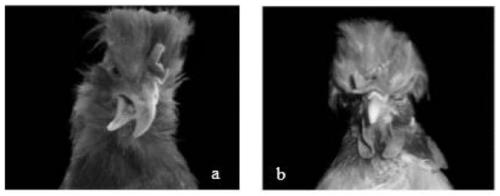A molecular marker related to chicken beak deformity traits and its application
A molecular marker and deformity technology, which is used in the determination/inspection of microorganisms, biochemical equipment and methods, DNA/RNA fragments, etc., to improve animal welfare, great economic application value and scientific research value, and reduce the probability of beak deformity.
- Summary
- Abstract
- Description
- Claims
- Application Information
AI Technical Summary
Problems solved by technology
Method used
Image
Examples
Embodiment 1
[0020] Example 1: Confirmation of the correlation between rs313625170 SNP molecular marker and chicken beak deformity traits
[0021] experiment material:
[0022] A case-control (case-control) experimental design was adopted, that is, it was divided into a chicken beak deformity group and a normal group, and the genotype differences between the two groups were compared to find out the loci related to the chicken beak deformity traits. The population to be tested comes from the Changping Experimental Base of the Beijing Animal Husbandry and Veterinary Research Institute. From the Beijing oil chicken population, 48 beak deformed individuals and 48 normal individuals were selected.
[0023] 1. Detection of SNP molecular markers
[0024] 1. Genomic DNA Extraction
[0025] (1) Collection of blood samples
[0026] Collect 1.0 mL of individual blood samples from test chickens by subwing vein blood sampling method, place them in centrifuge tubes that have been added with 0.2 mL of...
Embodiment 2
[0043] Example 2: Association analysis of individual rs313625170 SNP genotype and chicken beak deformity traits
[0044] experiment material:
[0045] A case-control (case-control) experimental design was adopted, that is, it was divided into a chicken beak deformity group and a normal group, and the genotype differences between the two groups were compared to find out the loci related to the chicken beak deformity traits. The population to be tested comes from the Changping Experimental Base of the Beijing Animal Husbandry and Veterinary Research Institute. From the Beijing oil chicken population, 48 beak deformed individuals and 48 normal individuals with obvious traits were selected.
[0046] 1. Detection of SNP molecular markers
[0047] 1. Genomic DNA Extraction
[0048] (1) Collection of blood samples
[0049] Collect 1.0 mL of individual blood samples from test chickens by subwing vein blood sampling method, place them in centrifuge tubes that have been added with 0....
Embodiment 3
[0077] Example 3: The effect of purifying beak deformity traits of Beijing oil chicken by using the genotype of rs313625170 locus
[0078] experiment material:
[0079] A total of 1249 Beijing oil chicken Y-series family groups hatched from the same batch in Changping Experimental Base of Beijing Animal Husbandry and Veterinary Research Institute were selected, including 206 brooding roosters and 1043 hens.
[0080] 1. Phenotype determination of beak deformity traits
[0081] Before the age of 28 days, the beak traits of the chickens were visually observed, and the individuals with beak deformities were counted. The results are shown in Table 6. The malformation rate of this generation (referred to as G1 generation) was 2.43% in roosters, 1.44% in hens, and 1.60% in mixed male and female populations.
[0082] Table 6 The number and proportion of beak deformities and normal individuals identified by phenotype in G1 before 28 days of age
[0083] character Rooster...
PUM
 Login to View More
Login to View More Abstract
Description
Claims
Application Information
 Login to View More
Login to View More - R&D
- Intellectual Property
- Life Sciences
- Materials
- Tech Scout
- Unparalleled Data Quality
- Higher Quality Content
- 60% Fewer Hallucinations
Browse by: Latest US Patents, China's latest patents, Technical Efficacy Thesaurus, Application Domain, Technology Topic, Popular Technical Reports.
© 2025 PatSnap. All rights reserved.Legal|Privacy policy|Modern Slavery Act Transparency Statement|Sitemap|About US| Contact US: help@patsnap.com



